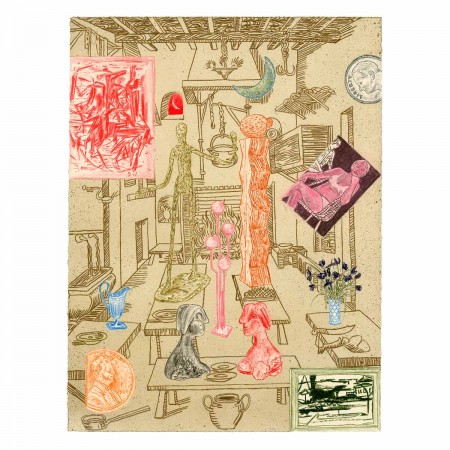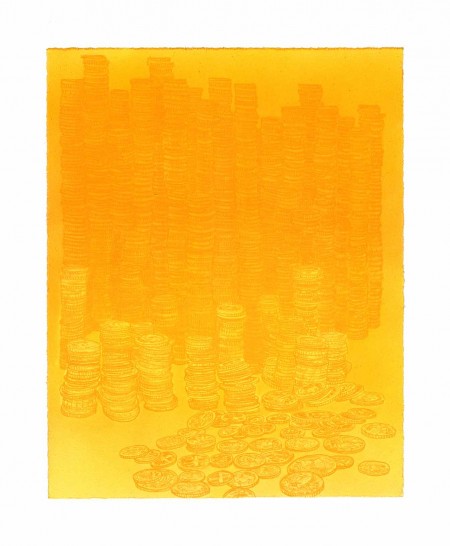
Interior 1
2016
colored pencil and acrylic on paper w/ custom frame inlayed with walnut and maple details
16 x 12 in (40.6 x 30.5 cm)
Michael Krueger (pronounced Kreeeger) has shown parts of the same body of work entitled Nondoing in two different places lately. Both exhibitions were two person shows: The first was held at Plant House Gallery in Midtown Manhattan which also featured Elizabeth Ferrill; it was called Possible Blueprint and ran from September thirteenth until the twenty-first of October. The second exhibition opened at The Reese Gallery in Saint Louis on October twelfth and also features ceramics by Alex Reed, that exhibition is called Nondoing. For the purposes of this review I’ll only be examining Krueger’s work, although I do strongly recommend Elizabeth Ferrill’s work as well as that of Alex Reed.
I spoke with Krueger on the sixth day of November and conducted one of the most personally productive artist interviews of my short journalistic career. It was nearly a year to the day four years ago that I saw Krueger lecture at UC/DAAP in Cincinnati. When I saw him speak he lectured about his series of lithographs Full Metal Journal which recount his personal teenage wasteland through his high school notebooks, his Endless Colony series which pits colonial soldiers against an absurdly psychedelic sublime, and then finally The Drop City Animations and ceramics which if I remember correctly DON’T have to do JUST with LSD, but more to do with people dropping stuff out of windows along main street in a small town in Kansas. Dropper culture is something you’ll have to investigate, dear reader. I remember one of the students in the crowd breaking the initial silence of the Q & A with “Um…have you like…done LSD?”
So, I’ve been familiar with Krueger’s work and was excited to talk to him because I have noticed a shift happening for a while now. This shift made for an hour and a half long conversation after which I was feeling motivated and worked all night long.
Krueger describes his current working habit as trying to meet his own criteria. I asked him what Nondoing was about though, and he couldn’t tell me. He more or less said that he didn’t know. Bumbling through the beginning of the interview I really didn’t know what to ask after he told me he wasn’t sure what his work was about. I can confidently tell you know that the rest of the interview was predicated on this admission.
The name of the body of work Nondoing is importantly borrowed from Alan Watts (1915-1973), an English ex-pat and Episcopalian Minister who fell in love with Zen and was instrumental in the delivery of Eastern cosmologies to Western Consciousness. Interestingly, of psychotropic drugs Watts said, “If you get the message, hang up the phone.”
For Krueger, this idea of Nondoing has to do with presence, trust, fearlessness, and a certain dismissal of the self-conscious mind, which our culture has become enormously prone entertaining. In adopting this space Krueger’s work has become far less literal. This space of simultaneity, of absence and presence, active and passive, is driving the car right now.
Riding shotgun is Painting. Krueger was not painting four years ago. He was painting about three years ago. Around that time he went to Dolphin Gallery to visit long-time friend and great gallerist, John O’Brien. As they got to talking they ventured into the back of the gallery to look at paintings. Instead of pulling them all the way out though they went about the racks examining the manneristic edge treatments of the different artists. Krueger said he was fascinated by the enormous content held in the small space of a painting’s edge. He said this really turned him on to craft.
So Krueger’s Nondoing is a series of objects or shaped paintings that are unified perhaps only by their nondoingness and then also by their being built objects. If you know his work you might pick-up on references to past works, but I doubt you’d find too many absolutely confirmed. I asked Krueger if he thought these shaped canvases he’s been making are dealing in novelty. I specifically pointed to my personal favorite, a pair of objects entitled Candle n Apple. The piece is exactly what the title claims. Krueger said that the objects are authentic. Novelty is beside the point. In our discussion of Candle n Apple I professed a meaning that I liked. For me, Candle n Apple is about the tokenness of object culture and knick knackery, which we refer to in the art verld as kitsch. The apple refers to academia through the cliché of students bringing apples to their teachers, and the burnt out candle refers to the time honored practice of burning the midnight oil, or perhaps burning the candle at both ends, since this isn’t the first or last candle we’ve seen from Krueger. From Candle n Apple I gathered a statement of brokenness about academia, that our systems are burnt out and that much of what is professed is equalized by its cliché.
Krueger doesn’t care to cater to defining his praxis in terms that satisfy finite notions of meaning. It would seem that he is in love with the simple idea of being present to the honest and risk filled process of creative generation.: the influence of Watts may well be present here.

two moons on the river, acrylic on linen on shaped panel & colored pencil on paper w/ custom frame inlaid w/ walnut and quarter moon 19″ x 40″
drawings 13″ x 10″ (frame size 16″ x 13″)
Two Moons on the River is another painting that I really like. It harnesses Krueger’s expertise in printmaking, drafting, painting, and woodworking all of which inform a wall-hanging sculpture. The painting is two monochromatic framed drawings of the moon, one in ochre, the other in blood red. They are joined by a section of stretched linen on which has been painted a series of playing cards cast astray against an ombre fading from taupe into crème. I’m going to give you my take again, mostly because the liberty I’m taking thrills me, and who knows how much longer I’ll be allowed it. Right away there’s the difference of color which suggests binary, the difference of perception between two individuals, and the simultaneous occurrence of these perspectives. The moon drawings are joined by a “river” which remains present but is always moving. The way Krueger has represented the idea of a river here is for me talismanic and meditative. The cards, wantonly tossed into the water, suggest contest and its fruitlessness. The struggles and oppositions of our present moment will be forgotten. The cards, for me, declare the value of cooperation. The moons too pose a question of separation. Do two quarters make a harvest moon?
Finally, I’d like to discuss some of the drawings, which are perhaps the most explicit works included in either exhibition. Krueger said that in the last year he’s probably produced about fifty in addition to another hundred. Most of them haven’t seen the light of day, and likely never will. The drawings are another exercise in free association and make heavy references to tropes within the history of modernism. The drawings feature interiors, which as far as I can deduce seem European. They are populated with American currency, masterpieces of the modern era i.e. Giacometti, Cezanne, Gorky, Kline, Brancusi etc. and some of the other worldly influences that modernists colonialized and appropriated for their exotic benefit. For instance, one of the drawings features an Iberian mask which is easily linked to Picasso. The drawings also include domestic items of the colonial era likes sterling milk pitchers and other household items. The items are all rendered monochromatically against a monochromatically sepia background. I think that more than the other works these drawings have critical content, without losing their meditative possibilities. The juxtaposing of items from the superior modern (the Western World) with items from the after modern (Africa), provides a postcolonial reading that is certainly critical. Whether this is intentional I am not certain. When we spoke on the phone Krueger spoke of the modernist works as being personal affects. When he visits the museum at SAIC he knows he’ll be revisiting staples of the collection. Every time is different, and in a way they are his. They become temporal reflections when they are visited again and again.
I think that global culture, and global exchange of the postcolonial discourse is certainly up for discussion in Krueger’s work. Formalist aesthetics are there too as is a discussion of capitalism in works such as All Gold where a pile of golden coins is transposed on a golden background. Krueger is making work from a place that is free of acknowledgement and very much alive in his moment. It seems to be working very effectively.

Interior 2
2016
colored pencil and acrylic on paper w/ custom frame inlayed with cut nickel
16 x 12 in (40.6 x 30.5 cm)
–Jack Wood





